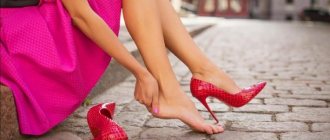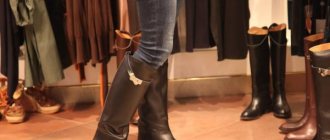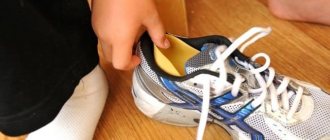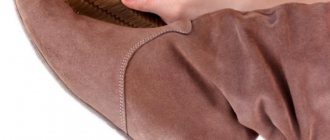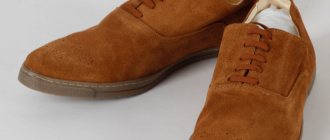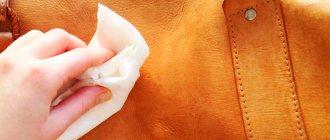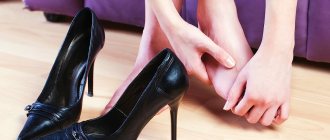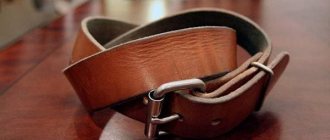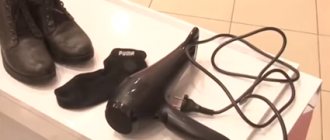Why do shoes rub your feet?
Everyone, at least once in their life, has bought shoes that, when worn for a long time, caused a feeling of discomfort. Even the most expensive shoes made of genuine leather can cause its owner a lot of inconvenience, causing calluses and unbearable pain.
Hard shoes cause discomfort to the owner, causing calluses and severe pain.
The main reason for the stiffness of new shoes is the low quality of the product. A bad last or improper tailoring provokes inconvenience, discomfort, and an unattractive gait.
But not only new shoes can turn into a real disaster for their owner. During wear, some leather models also become rough and hard. The cause may be exposure to dirt, water, sweat, as well as improper drying, for example, on a radiator or heater.
Special pad
Typically, such tools are used in workshops for shoe repair and stretching. But no one forbids having it at home.
Shoe stretching pads are sold in stores. They are shaped like a leg, so the material takes on the desired shape.
The special lasts also come with attachments that allow you to correct certain areas of your shoes.
Is it possible to return hard shoes to the store?
If you nevertheless purchased shoes or sneakers and after a walk you find that they are rubbing your feet, is it possible to return such shoes to the seller? Make no mistake, they will not be accepted back with such a claim. If no manufacturing defects are found on the shoes, which are revealed through examination, it is impossible to return them to the store after wearing them.
Factory defects in shoes can only be detected through a special examination.
Another case is also possible: you have not had time to wear the boots and the warranty period (14 days from the date of purchase) has not yet expired. The boots have not lost their consumer appearance, but you have already realized that they are made of rough leather and will rub your feet. Then try contacting the seller, present your unworn shoes, receipt, packaging, all labels and say that this product did not suit you in its shape, size, color, style, dimensions. There is a high probability that you will defend your rights and you will get your money back or be offered another product.
Paraffin and soap
Hard shoes can be stretched at home using paraffin and soap.
This method is suitable if the products are needed in a few hours, and you need to distribute them quickly.
You can soften hard shoes in this way: rub them from the inside with a paraffin candle or soap. Put your shoes on right away.
This method is used for rough suede or genuine leather.
Paraffin and soap make shoes very soft. After using them, calluses will not appear on your feet.
To soften your shoes, contact a workshop
In the case when you already like the new shoes, and you don’t want to part with them even after they have rubbed more than one callus, you can give your new shoes to a specialist to soften them. This is done in any shoe shop.
Please note: the master will only accept shoes made from genuine leather or suede for softening.
To knead a pair of other materials, try using folk recipes.
Kerosene
You can simultaneously soften the material and stretch it using kerosene.
How to soften shoes at home with this flammable product:
- First, the shoes must be wetted with warm water.
- They are then treated with kerosene. To do this, soak a cloth in the mixture and apply it to the surface of the shoe. Kerosene should not drain from them, just lightly treat the surfaces.
- Then the products should be dried.
This method is definitely good. However, after using it, your boots may smell unpleasant.
Take the boots out into the fresh air and leave them there until all the smell has disappeared.
How to soften shoes yourself: home remedies
The most proven method for wearing shoes, which was used by our grandmothers, is woolen socks. Soak them in alcohol or vodka, put on your shoes and walk around in them for as long as possible. Alcohol will have an aggressive effect on the surface of the shoe, and the sock will help it stretch faster.
This method is great for softening the seams of fabric sneakers. When stretching leather shoes, it is better not to use alcohol.
How to stretch natural and artificial leather
If the shoes made of genuine leather are very hard, place a soft cloth on the hard part and lightly tap the desired area with a hammer, then walk in the shoes. There is an effect - good, no - try again, but do not overdo it, so as not to spoil the product.
Faux leather shoes can also be softened a little by using newspapers.
- Wet the crumpled pieces of newspaper.
- Stuff your shoes tightly with them.
- Leave until completely dry.
Some sources suggest softening shoes with glycerin or sunflower oil. We do not recommend that you use these products. Although sunflower oil will soften the skin, over time it will become even rougher. Glycerin will also give a good effect at first, but then the leather on the shoes will begin to crack.
How to make leather shoes soft - video
Removing the stiffness of patent leather shoes and boots
How to “make” new, but not too soft patent leather shoes “love” your feet? Models with a varnished surface require delicate handling. One of the most effective ways to soften this material is any greasy cream and a hair dryer.
- Apply the cream to the inside of your shoes.
- Warm it up thoroughly from the inside.
- Wear thick socks.
- Put on shoes and walk for as long as possible.
Monitor the temperature while warming up; shoes that are too high may lose their shine.
Softening shoes with a hairdryer - video
How to break in suede and nubuck shoes
You can soften suede shoes using the same methods that are used for leather products:
- mechanical (hammering);
- hot (using a hairdryer);
- treatment with a skin softening spray purchased in a store.
Treatment with a special spray helps soften hard shoes
To soften nubuck, it is better to buy special foam or seek the help of professionals.
Please note that nubuck is capricious and does not like any greasy creams, alcohol, or Vaseline, which leave streaks and stains on its surface.
To prevent shoes from rubbing: useful life hacks - video
Secrets of stretching rubber and tarpaulin boots
It is very easy to soften rubber shoes. This material is durable, so it can be processed with ordinary boiling water without fear or risk.
- Pour boiling water into your boots.
- When the water has cooled down a little, put on several pairs of warm socks and boots on top.
- Walk for 15–20 minutes, then cool the boots in cold water, vigorously moving your toes.
After this treatment, the rubber takes the shape of the foot and stops rubbing.
You can soften rubber boots by using boiling water and then cooling
Sometimes it is necessary to soften tarpaulin boots. These shoes are made from several layers of durable cotton fabric soaked in a rubber solution. Experts recommend applying emollients to problem areas:
- hot goose fat;
- Birch tar;
- a mixture of beeswax and teak oil;
- Castor oil.
Hot air
You can stretch the boots so that they do not rub when you first put them on using vegetable oil and a hairdryer.
This method is suitable for thin leather products.
How to soften shoes:
- Treat the entire surface with vegetable oil or cream.
- To make your shoes softer, wear them with a thin sock.
- Turn on the hairdryer, but the air flow should not be very hot, but warm. Point the hair dryer at the product and warm it up thoroughly.
After completing the procedure, you do not need to immediately wipe off the oil. Walk around in the shoes for a while, wait until they cool down and take the shape of your feet. Then you can remove the product and wipe off the vegetable oil with soapy water.
Getting rid of hard heels
An ordinary paraffin candle or laundry soap will help soften the backdrops a little. Rub one of these products on the inside of the heel of your shoe and try walking. You can also soften the backdrop with vinegar, generously moistening the skin in the problem area.
Alcohol diluted with water in a 1:1 ratio will help make artificial shoe materials soft. Moisten the backdrop with it and “break” it with your hands. Before the procedure, make sure that there is no cardboard insert in the heels; if it gets wet, it will get wet and the shoes will lose their shape.
Alcohol
Alcoholic drinks also soften well.
This method is not suitable for all materials, so before using it, check the reaction of the boots to alcohol, and only then use it for the procedure.
How to make shoes softer:
- Pour a small amount of vodka or rubbing alcohol into a spray bottle.
- Spray the product on the inside. Treat well those areas where the shoes are too tight.
- Then put on your shoes and walk around the house a little. You can stuff them with newspapers if they are wearing high heels and your feet are already chafing.
To replace alcohol and vodka, use regular cologne or perfume. They also contain some alcohol and can soften the material.
In addition, after using men's cologne or women's perfume, a pleasant aroma will emanate from the shoes for a long time.
How to restore white sneaker soles to their original appearance
Washing powder
To clean the dirty white surface of the sneakers, you need to prepare a soap solution:
- Take ½ cup of powder.
- Add slightly cooled boiled water.
- Place shoes in the solution.
- Leave for 30 minutes.
- Clean the surface with a hard brush.
- Rinse.
- Wipe until dry.
You can use another cleaning product as a base for the solution.
Method 2
You can glue pieces of sandpaper or felt to the sole, they will also make the adhesion to the surface better. In addition, you can find sole stickers on sale that perform the same function. As an option, you can stick a fabric adhesive plaster on the sole, but in slushy weather it, alas, will quickly fall off.
If the callus has already appeared
Calluses can be wet, dry or internal. It is quite possible to cope with the first two on your own; the internal calluses are removed by a surgeon.
Wet callus
A wet callus is a skin blister of different diameters. It is not advisable to burst it to avoid infection.
Be sure to read:
How and how to seal or restore the soles of sneakers, boots, winter and summer shoes
If the blister bursts, then apply antiseptic and wound-healing ointment. The skin cannot be peeled off.
The callus is covered with a plaster, preferably a large one. The white area of the patch should completely cover the diameter of the loose skin.
Note! Zelenka and iodine dry the skin and slow down healing.
Dry callus
A dry callus is an almost cured wet callus. It looks like a white leathery growth that comes off quite easily from the foot.
The easiest way to get rid of dry calluses is with a pumice stone or a special brush. Before the procedure, your feet need to be steamed.
It is important here that after removing excess skin and drying the feet, make sure that there are no dried hangnails left. They need to be trimmed carefully so as not to provoke the appearance of small wounds.
You can buy a special patch for calluses at the pharmacy. It contains salicylic acid, which softens the skin. The patch is applied to the callus overnight.
Which sole will not slip?
The sole should not be slippery. The safest is corrugated. It’s good if the sole bends easily. A heel is required, but not higher than 20 mm.
Interesting materials:
How long does the brigade take? How many players from each team take part in a volleyball game? How much ginger should you put in tea? How many instruments are in the orchestra? How much feces are in tomatoes? How many calories does bread fried in eggs have? How many calories are in 1 large Gingerbread? How many calories are in 1 Dumpling? How many calories are in 100 g of boiled noodles? How many calories are in 100 jumping ropes?
